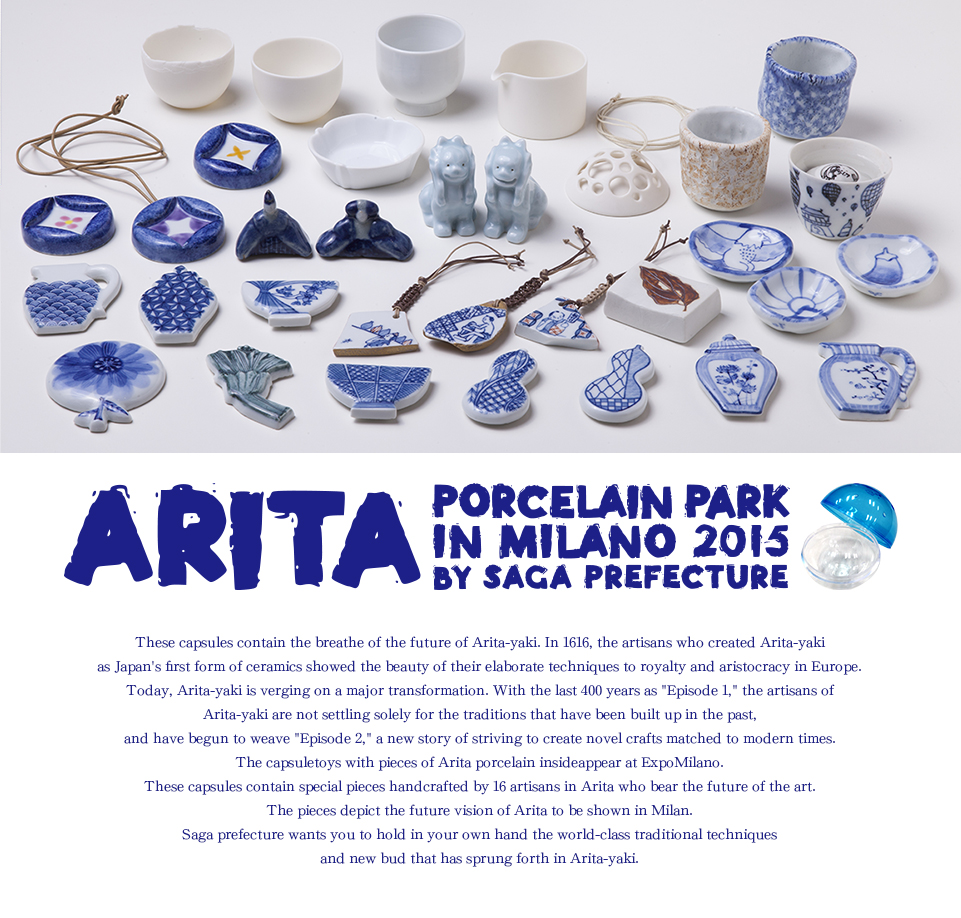



Arita Sarayama
Artisans Dolls●Arita Sarayama Artisans Dolls
These are miniature porcelain dolls that were crafted with Arita porcelain concepts for a souvenir. We created eight types of mascot figures of artisans carrying wares on their shoulder or at the potter’s wheel, for example, based on the Illustrated Map Platter of Sometsuke Arita Sarayama Artisans in which a scene of artisans at work is depicted within the perfect division of labor system in Edo Japan.
SATORU NIINAI
MEGUMI HASHIOKA
YUKARI OOGUSHI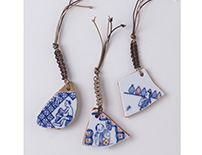
Porcelain Fragment Ornament●Porcelain Fragment Ornament
Unglazed fragments from pottery wares that broke during the creation process and become unusable before they are fired are given a breath of new life. Gold-dusted lacquer is painted onto the broken edges of the fragment with the traditional Japanese kintsugi technique that beautifully accentuates broken lines, creating a stunning expression. The pattern depicts each individual involved in the Arita porcelain processes, such as shaping the piece on the potter’s wheel and drawing on the design. This small piece of Arita porcelain can be carried with you always, as a bag or cell phone trinket or pendant around your neck.
RINA YANO
Facebook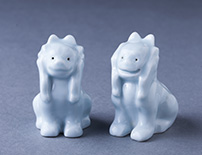
Sueyama Shrine Koma-inu Guardian Dogs (A-Un)●Sueyama Shrine Koma-inu Guardian Dogs (A-Un)
Koma-inu guardian dogs are statues placed on either side of a shrine entrance or in front of the sanctuary to ward off evil. They are usually made of stone, but Tozan Shrine in Arita that is dedicated to the pottery master Yi Sam-pyeon has ones made of porcelain, distinctive of a pottery town. They were made with care given to the unique expression of porcelain that cannot be seen at other shrines. This miniature koma-inu was made with the hope that it would be your ticket to Arita and inspire you to go and see the actual beautiful porcelain koma-inu at Sueyama Shrine.
ANNA NAGANUMA
Hina Doll●Hina Doll
Hinamatsuri is a traditional Japanese festival to pray for girls to grow in good health. Praying for healthy growth of children is universal to all countries. Because of this, I thought people around the world would be able to understand Hina dolls. Soil from the Arita dam was used and blue and white glaze was used to draw the design. I emphasized use of distinctive Arita elements to create this piece.
CHIHIRO BESSHO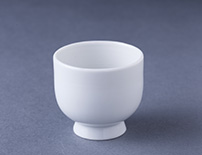
White Porcelain Sake Cup●White Porcelain Sake Cup
This sake cup highlights the translucent white color of white porcelain that is a main feature of Arita porcelain wares. Each of the 40 one-of-a-kind pieces with their own unique shape was carefully crafted one by one with great care towards practical utility. Enjoy Japanese sake in a Japanese cup as a dinnertime drink to suit your meal.
DAISUKE MATSUNAGA
Tebineri Sake Cup●Tebineri Sake Cup
I sense a distinctive inorganic and expressionless tension in porcelain. While that is also a strength of porcelain, I did not want to create porcelain with this hard sensation; rather, I wanted to create soft porcelain produced by the flexibility of the earth. To achieve this, I used the tebineri hand-building technique to create this sake cup. Each finger mark is an etching of the momentary sentiment of the creator, and the resulting complex expression sparks a lively shine in the cup. This cup gives a sense of warmth when you look at it, touch it, and use it.
HAYATO IIDA
Facebook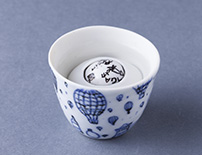
Saga-mon Shikake Sake Cup●Saga-mon Shikake Sake Cup
This piece was based on a Shirei-hai sake cup that has been made in China since long ago. A Shirei-hai is a special type of sake cup in which dolls pop out when the sake is poured into it. I used this special trick to make a sake cup that lets you enjoy the charms of Saga. The exterior is a design depicting a balloon in flight over Saga, based on the SAGA International Balloon Fiesta, an international event held in Saga each year. The ball inside contains drawings of various Saga specialties that can be seen when traveling through the prefecture. I hope this cup with a special trick instills wonder about what type of place Saga is.
HAYATO IIDA
Facebook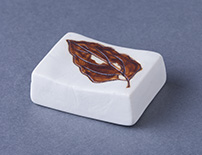
Fossil Chopstick Rest●Fossil Chopstick Rest
Many pottery fragments can be found here in Arita. Some are quite new, but some were made 400 years ago. While these fragments no longer have their original shape, they still retain the luster from the moment they were placed in the kiln. Similarly, the pieces we craft today will remain for hundreds of years. Perhaps pottery can be considered fossils created by humans. Those fossils hold the sentiment of their creator. That sentiment that is preserved over oceans and time can be traced back to our current moment in Arita.
HITOSHI YOSHINO
Facebook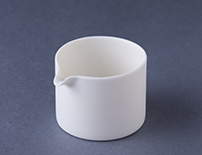
Pitcher●Pitcher
I wanted to make something for the capsule that was the most practical item and the item that is most constantly used in daily life. I felt that there is a sense of Arita that you can feel when objects blend into ordinary life. The spout was carefully shaped to reduce dripping, thoroughly pursuing great usability. I hope this pitcher will be used for milk or salad dressing.
HITOSHI YOSHINO
Facebook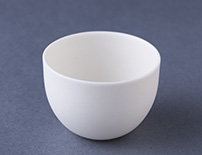
Egg Dish●Egg Dish
Arita porcelain was once made from pottery stones from the Izumiyama quarry, but as time went on, the raw material was shifted to better quality Amakusa stone. However, the supply of Amakusa stone is not limitless. The time will eventually come when the source of raw materials must be changed. Although the material will change, the spirit of us in Arita will not. With that in mind, I aim to create a new material using mixed kaolin that will become the new Arita white. I hope this piece will be used as a cup for drinking Japanese sake, egg stand, or accessory holder.
HITOSHI YOSHINO
Facebook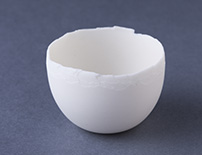
Eggshell Dish●Eggshell Dish
This dish was made from translucent kaolin with a kaolin layering technique that was developed by searching for a beautiful expression by peeling away the outer layers of kaolin. This new Arita porcelain shape can be enjoyed as a cup for drinking Japanese sake or beautiful decorative piece.
HITOSHI YOSHINO
Facebook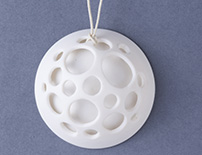
skele cup●skele cup
There is a special type of cup for tasting sake called a “tastevin” that a sommelier hangs from his or her neck. This was remade into a cup for Japanese sake and fashion piece. I hope this sake cup will be used to enjoy Japanese sake should the opportunity arise.
HITOSHI YOSHINO
Facebook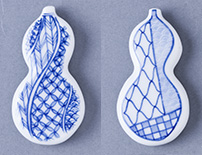
Gourd Magnet●Gourd Magnet
Gourds are popular in Japan as a symbol of bringing good luck and warding off bad luck and evil, and bringing prosperity to business and descendants. This gourd has been painted with a traditional Arita pattern and fitted with a magnet. See, use, and enjoy this traditional Japanese form and pattern in your home or workplace.
PARK CHAEWON
Facebook
HIROYUKI TSUJI
Rice Bowl Magnet●Rice Bowl Magnet
Rice bowls are an essential dining tool for Japanese daily life. This gourd has been painted with a traditional Arita pattern and fitted with a magnet. See, use, and enjoy this traditional Japanese form and pattern in your home or workplace.
PARK CHAEWON
Facebook
HIROYUKI TSUJI
Magnet Pot / Jug / Round Flower / Side Flower●Magnet Pot / Jug / Round Flower / Side Flower
Arita porcelain was once taken overseas to amaze the people of Europe and beautifully decorated the palace. It remains a source of pride for Japanese people. However, maybe few people in Europe know that this style is actually Arita porcelain. We created these magnets to revive knowledge of the Arita origin based on motifs of the shapes of pots and other objects that once decorated the palace. Stick them on your refrigerator or somewhere else to enjoy traditional Japanese patterns such as woven patterns and flower-bird patterns each day while pondering about Arita off in the distance.
KUMIKO YADA
Facebook
SHINO TAKAHASHI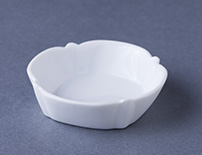
Small Dish●Small Dish
Small dishes are so cute that you will want to collect them. I created a design that depicts the elaborate beauty of Arita porcelain in that tiny world. Plates only become plates when something is placed on top of them, and patterns sometimes do not match or actually interfere with the plate’s contents. I made this small dish white porcelain on the upper side and created a design on the underside with cherry blossoms that are the flower that represents Japan. Translucent kaolin was used so that light shining onto the dish makes the red paint of the cherry blossoms stand out, creating a nighttime cherry blossom atmosphere.
KUMIKO YADA
Facebook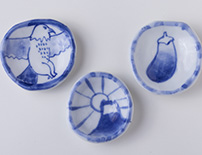
First Mt. Fuji, Second Hawks,
Third Eggplants Small Plate●First Mt. Fuji, Second Hawks, Third Eggplants Small Plate
In Japan, there is a saying “first Mt. Fuji, second hawks, third eggplants” that refers to the order of visions that are considered lucky if they appear in one’s first dream of the year. This small plate is infused with my wish to deliver these three auspicious objects to the people of Milan. The piece was created with a tebineri hand-building method to produce a warm handmade texture and the pattern was drawn with Arita’s traditional blue and white glaze technique.
AKARI OOGI
HADUKI FUKUDA
Instagram
Shippo-mon Brooch●Shippo-mon Brooch
Shippo is a Buddhist word referring to the seven treasures: gold, silver, lapis lazuli, quartz, coral, agate, and giant clamshell. Also, the circles in the shippo pattern have been popular in Japan as a lucky pattern since ancient times for symbolizing peace and harmony. Shippo-mon is usually drawn as a pattern, but here I used plaster to create a raised pattern that adds interest. This Arita porcelain piece can be used as a fashion accessory on your clothes or bag.
YOSHIMI MORI
Facebook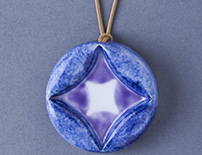
Shippo-mon Strap●Shippo-mon Strap
Shippo is a Buddhist word referring to the seven treasures: gold, silver, lapis lazuli, quartz, coral, agate, and giant clamshell. Also, the circles in the shippo pattern have been popular in Japan as a lucky pattern since ancient times for symbolizing peace and harmony. Shippo-mon is usually drawn as a pattern, but here I used plaster to create a raised pattern that adds interest. This Arita accessory is a great accent for daily life, with its large size and brilliant luster.
YOSHIMI MORI
Facebook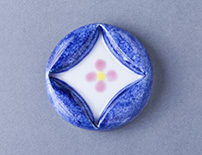
Shippo-mon Cutlery Rest●Shippo-mon Cutlery Rest
Shippo is a Buddhist word referring to the seven treasures: gold, silver, lapis lazuli, quartz, coral, agate, and giant clamshell. Also, the circles in the shippo pattern have been popular in Japan as a lucky pattern since ancient times for symbolizing peace and harmony. Shippo-mon is usually drawn as a pattern, but here I used plaster to create a raised pattern that adds interest. This Arita porcelain piece can be used as a cutlery rest to lay down your spoon or fork on, adding a decorative touch to your day-to-day life.
YOSHIMI MORI
Facebook

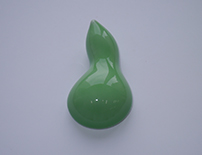
Gourd in blue●Gourd in blue
Gourds are often used in Japan to bring good luck and ward off bad luck and evil.
KITAGAWA BISENGAMA
KITAGAWA BISENGAMA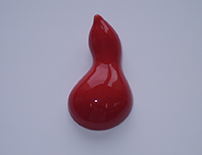
Gourd in red●Gourd in red
Gourds are often used in Japan to bring good luck and ward off bad luck and evil.
KITAGAWA BISENGAMA
KITAGAWA BISENGAMA
Sabikara-yaki Peanut●Sabikara-yaki Peanut
A chopstick rest shaped like a peanut that is also a common finger food in Japan.
KITAGAWA BISENGAMA
KITAGAWA BISENGAMA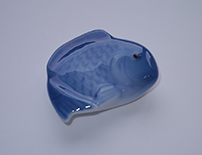
Gomafuki (Sesami)
Sea Bream●Gomafuki (Sesami) Sea Bream
Based on the motif of a sea bream fish that is an essential part of celebrations in Japan.
KITAGAWA BISENGAMA
KITAGAWA BISENGAMA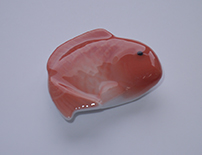
Akafuki (Red)
Sea Bream●Akafuki (Red) Sea Bream
Based on the motif of a sea bream fish that is an essential part of celebrations in Japan.
KITAGAWA BISENGAMA
KITAGAWA BISENGAMA
Mutsugoro●Mutsugoro
This is a cute animal that lives in the Ariake Sea tidal flats in Saga Prefecture.
KITAGAWA BISENGAMA
KITAGAWA BISENGAMA
Pink Pig●Pink Pig
Pigs are a also common motif for money boxes and symbolize wealth in Japan.
KITAGAWA BISENGAMA
KITAGAWA BISENGAMA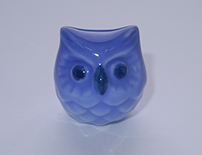
Mini Owl in blue●Mini Owl in blue
Owls are familiar good luck birds in Japan as the Japanese word for owl, fukuro, is a homonym for ”no labor”and”good fortune”.
KITAGAWA BISENGAMA
KITAGAWA BISENGAMA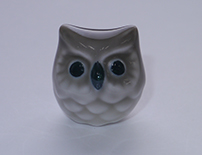
Mini Owl in brownMini Owl in brown
Owls are familiar good luck birds in Japan as the Japanese word for owl, fukuro, is a homonym for ”no labor”and”good fortune”.
KITAGAWA BISENGAMA
KITAGAWA BISENGAMA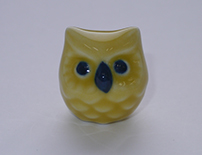
Mini Owl in yellow●Mini Owl in yellow
Owls are familiar good luck birds in Japan as the Japanese word for owl, fukuro, is a homonym for ”no labor”and”good fortune”.
KITAGAWA BISENGAMA
KITAGAWA BISENGAMA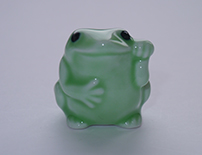
Maneki Kaeru
(Beckoning Frog)●Maneki Kaeru (Beckoning Frog)
The Japanese word for frog, kaeru, symbolizes safe arrival and receiving good fortune, for example, and is said to be a symbol of safe travel and bringing good luck in Japan.
KITAGAWA BISENGAMA
KITAGAWA BISENGAMA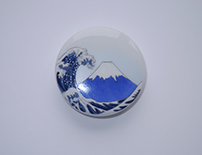
Mt. Fuji Magnet (blue)●Mt. Fuji Magnet (blue)
Mt. Fuji is the highest mountain in Japan. It is said to be very lucky to see it in your first dream of the new year.
ARITA TOUGEI
ARITA TOUGEI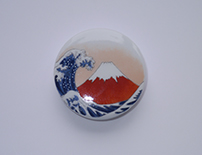
Mt. Fuji Magnet (red)●Mt. Fuji Magnet (red)
Mt. Fuji is the highest mountain in Japan. It is said to be very lucky to see it in your first dream of the new year.
ARITA TOUGEI
ARITA TOUGEI
Mini Colored Carp:
Set of two
(red and white, tricolored)●Mini Colored Carp: Set of two (red and
white, tricolored)
Carp are considered a talisman for social success based on the legend that carp climb waterfalls to become a dragon.
ARITA TOUGEI
ARITA TOUGEI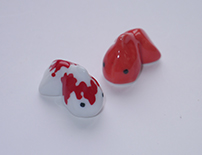
Mini Goldfish: Set of
two (red and white, red)●Mini Goldfish: Set of two (red and white, red)
Goldfish are lucky charms that are said to bring economic fortune in Japan.
ARITA TOUGEI
ARITA TOUGEI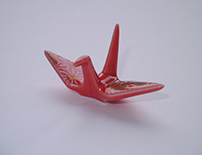
Folded Paper Colored
Crane in red●Folded Paper Colored Crane in red
Since ancient times in Japan, cranes have been considered a lucky bird for their great longevity.
ARITA TOUGEI
ARITA TOUGEI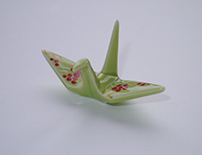
Folded Paper Colored Crane in green●Folded Paper Colored Crane in green
Since ancient times in Japan, cranes have been considered a lucky bird for their great longevity.
ARITA TOUGEI
ARITA TOUGEI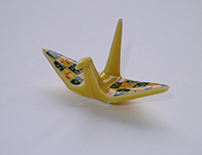
Folded Paper Colored Crane in yellow●Folded Paper Colored Crane in yellow
Since ancient times in Japan, cranes have been considered a lucky bird for their great longevity.
ARITA TOUGEI
ARITA TOUGEI
Folded Paper Colored Crane in lapis lazuli●Folded Paper Colored Crane in lapis lazuli
Since ancient times in Japan, cranes have been considered a lucky bird for their great longevity.
ARITA TOUGEI
ARITA TOUGEI
Folded Paper Colored Crane in white●Folded Paper Colored Crane in white
Since ancient times in Japan, cranes have been considered a lucky bird for their great longevity.
ARITA TOUGEI
ARITA TOUGEI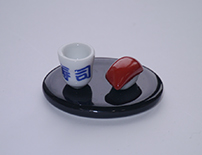
Mini-mini Sushi Rest:
Maguro●Mini-mini Sushi Rest:Maguro
Sushi made with fresh seafood is a traditional Japanese food that is enjoying great popularity these days.
ARITA TOUGEI
ARITA TOUGEI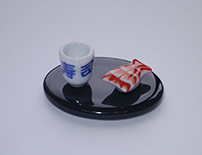
Mini-mini Sushi Rest:
Shrimp●Mini-mini Sushi Rest:Shrimp
Sushi made with fresh seafood is a traditional Japanese food that is enjoying great popularity these days.
ARITA TOUGEI
ARITA TOUGEI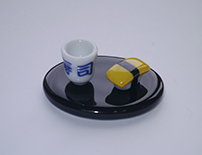
Mini-mini Sushi Rest:
Egg●Mini-mini Sushi Rest:Egg
Sushi made with fresh seafood is a traditional Japanese food that is enjoying great popularity these days.
ARITA TOUGEI
ARITA TOUGEI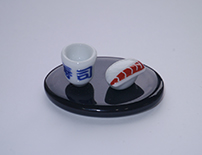
Mini-mini Sushi Rest:
Sea Bream●Mini-mini Sushi Rest:Sea Bream
Sushi made with fresh seafood is a traditional Japanese food that is enjoying great popularity these days.
ARITA TOUGEI
ARITA TOUGEI
Mini-mini Sushi Rest: Sea Urchin●Mini-mini Sushi Rest: Sea Urchin
Sushi made with fresh seafood is a traditional Japanese food that is enjoying great popularity these days.
ARITA TOUGEI
ARITA TOUGEI
Mt. Fuji Geta (red)
Blue Fuji●Mt. Fuji Geta(red) Blue Fuji
Japanese traditional geta clogs with a picture of Mt. Fuji that is considered auspicious.
ARITA TOUGEI
ARITA TOUGEI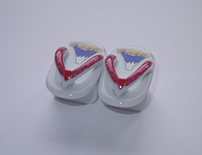
Mt. Fuji Geta (white)
Blue Fuji●Mt. Fuji Geta (white) Blue Fuji
Japanese traditional geta clogs with a picture of Mt. Fuji that is considered auspicious.
ARITA TOUGEI
ARITA TOUGEI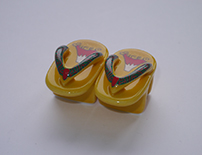
Mt. Fuji Geta (yellow)
Red Fuji●Mt. Fuji Geta (yellow) Red Fuji
Japanese traditional geta clogs with a picture of Mt. Fuji that is considered auspicious.
ARITA TOUGEI
ARITA TOUGEI
Mt. Fuji Geta (black)
Red Fuji●Mt. Fuji Geta (black) Red Fuji
Japanese traditional geta clogs with a picture of Mt. Fuji that is considered auspicious.
ARITA TOUGEI
ARITA TOUGEI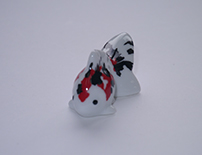
New Goldfish: Tricolor●New Goldfish: Tricolor
Goldfish are lucky charms that are said to bring economic fortune in Japan.
ARITA TOUGEI
ARITA TOUGEI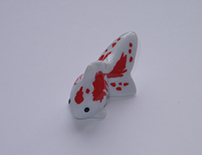
New Goldfish: Red and White●New Goldfish: Red and White
Goldfish are lucky charms that are said to bring economic fortune in Japan.
ARITA TOUGEI
ARITA TOUGEI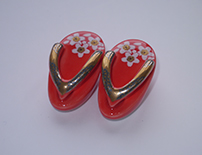
Four Seasons Zori (Cherry Blossom)●Four Seasons Zori (Cherry Blossom)
Zori are traditional Japanese sandals. These have a pattern of plants from each of the four seasons.
ARITA TOUGEI
ARITA TOUGEI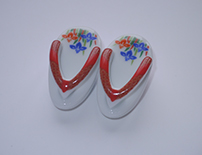
Four Seasons Zori (Iris)●Four Seasons Zori (Iris)
Zori are traditional Japanese sandals. These have a pattern of plants from each of the four seasons.
ARITA TOUGEI
ARITA TOUGEI
Four Seasons Zori
(Autumn Leaves)●Four Seasons Zori (Autumn Leaves)
Zori are traditional Japanese sandals. These have a pattern of plants from each of the four seasons.
ARITA TOUGEI
ARITA TOUGEI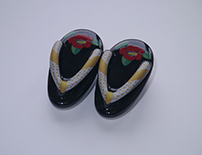
Four Seasons Zori
(Camellia)●Four Seasons Zori (Camellia)
Zori are traditional Japanese sandals. These have a pattern of plants from each of the four seasons.
ARITA TOUGEI
ARITA TOUGEI
4.5 cm Mini
Ornamental Plate:
Helmet●4.5 cm Mini
Ornamental Plate:Helmet
Miniature plate with a picture of a helmet that is Japan's traditional protective gear.
ARITA TOUGEI
ARITA TOUGEI
4.5 cm Mini
Ornamental Plate:
Carp Streamers●4.5 cm Mini Ornamental Plate:
Carp Streamers
Carp streamers are hung above the garden to pray for success and health of boys. This miniature plate features a picture of a traditional Japanese custom.
ARITA TOUGEI
ARITA TOUGEI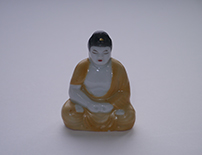
Daibutsu Buddha
Statue●Daibutsu Buddha
Daibutsu are large statues of Buddha of which many have been made in Japan since long ago to pray for peace and happiness for people.
KOSUZU TOUGEI
KOSUZU TOUGEI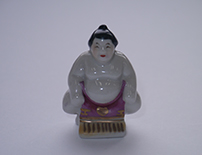
Sumo (variety)●Sumo (variety)
Sumo is Japan's traditional martial art in which wrestlers grapple on a ring as a Shinto ritual and celebration.
KOSUZU TOUGEI
KOSUZU TOUGEI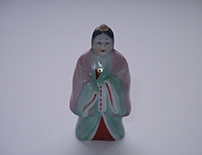
Junihitoe●Junihitoe
The twelve-layered ceremonial kimono that is traditional female clothes in Japan is vivid and colorful.
KOSUZU TOUGEI
KOSUZU TOUGEI
Kantai●Kanta
A motif of an ancient civil servant in Japan.
KOSUZU TOUGEI
KOSUZU TOUGEI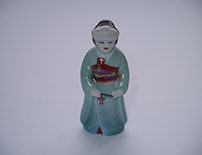
Bride●Bride
A doll wearing a white kimono that is the traditional Japanese wedding costume of a bride.
KOSUZU TOUGEI
KOSUZU TOUGEI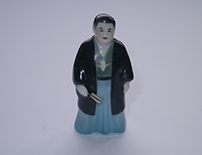
Groom●Groom
A doll wearing a hakama with the family crest that is the traditional Japanese wedding costume of a groom.
KOSUZU TOUGEI
KOSUZU TOUGEI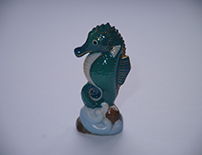
Seahorse (green)●Seahorse (green)
In Japan, seahorses are carried as a talisman for easy childbirth.
KOSUZU TOUGEI
KOSUZU TOUGEI
Seahorse (blue)●Seahorse (blue)
In Japan, seahorses are carried as a talisman for easy childbirth.
KOSUZU TOUGEI
KOSUZU TOUGEI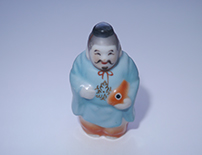
Ebisu●Ebisu
Ebisu is one of the seven deities of good fortune. It is the deity of prosperous business.
KOSUZU TOUGEI
KOSUZU TOUGEI
Daikoku●Daikoku
Daikoku is one of the seven deities of good fortune. It is the deity for an abundant harvest.
KOSUZU TOUGEI
KOSUZU TOUGEI
Juro●Juro
Juro is one of the seven deities of good fortune. It is the deity for a long and happy life.
KOSUZU TOUGEI
KOSUZU TOUGEI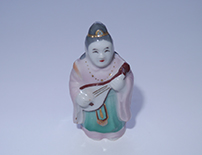
Benten●Benten
Benten is one of the seven deities of good fortune. It is the deity of learning, virtue, and crafts.
KOSUZU TOUGEI
KOSUZU TOUGEI
Hotei●Hotei
Hotei is one of the seven deities of good fortune. It is the deity of flourishing business.
KOSUZU TOUGEI
KOSUZU TOUGEI










































































